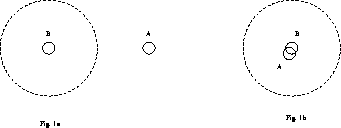
Figure 1:

B. Morando
Bureau des longitudes, URA 707 du CNRS
77, av. Denfert-Rochereau 75014 Paris
e-mail : morando@imcce.fr
The photometric observations of mutual phenomena of natural satellites give very good astrometric results but the reduction of such phenomena should be carried out very carefully.
Obvious mistakes during the time of observation, such as measuring the wrong satellite, can be easily avoided if the observation has been carefully prepared. Small maps of the field at times near the phenominon to be obseved can be provided. A list of the more important aspects of the reduction is given below.
1) As the observations are meant for astrometry they should be dated as precisely as possible in the UTC scale. A precision of 0.5s is desirable. The internal clock of a computer is not reliable and should be compared to the UTC scale. It also should be kept in mind, when establishing the O-C, that the ephemeris of the satellites involved are usualy given in a uniform scale (pratically TAI +32.84s).
2) The satellite or satellites involved must be inside a diaphragm. The situation varies, as shown on fig 1, according to the type of phenomenon (occultation or eclipse) and the angular distance of the satellites. If satellite B, for example, is eclipsed by satellite A and is far enough from A on the celestial sphere it can be put alone in the diaphragm so that the difference between the minimum and the maximum of the light-curve will be as great as possible (fig. 1a). In case of a occultation, on the other hand, it es unavoidable to have both satellites inside the diaphragm (fig. 1b). Another important point is not to have too big a diaphragm as the light diffused from Jupiter may be troublesome. A 30 arcsec diaphragm is usually satisfactory.
3) The integration time depends on the photometer used. It is around 1s to 2s.
4) The favourable wavelengths for the observations are in the V band or R band. In big cities where the background es very luminous the wavelenths between 500 nm and 530 nm are best (fig 2). Proper filters should then be used.
5) The background sky luminosity should be measured at regular intervals or time during an observation as it may vary significantly during the observation. This happens when the altitude of the object observed changes or when a twilight effect is to be feared. A curve fit of the background sky should then be substracted from the global light curve (fig 3).
6) Although only relative astrometry is required it is advisable to observe calibration objects when it is possible.
